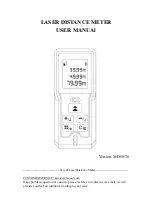
1-24
IM WT3001E-51EN
1.9 Computing the Motor Efficiency and Total
Efficiency
From the active power that this instrument measures and the motor output determined
in section 1.7, this instrument can compute the motor efficiency (the ratio of the motor
output versus the power consumption by the motor) and total efficiency.
*
Set the
equation according to the procedures given in section 5.7 or 5.4 in the
User’s Manual IM
WT3001E-01EN
. Computation examples are indicated below.
* The ratio of the motor output versus the power consumption by the motor as well
as the converter through which power is fed to the motor.
When the Motor Input Is Wired to ΣA
× 100
Motor output Pm*(W)
PΣ
A(W)
Motor efficiency (%) =
* Motor output Pm derived in section 1.7.
Motor
Motor output Pm
Power consumption
by the motor
P
Σ
A
When the Converter and Motor Inputs Are Wire to ΣA and ΣB, Respectively
× 100
Motor output Pm*(W)
PΣ
B(W)
Motor efficiency (%) =
× 100
Motor output Pm*(W)
PΣ
A(W)
Total efficiency (%) =
* Motor output Pm derived in section 1.7.
Converter
(Inverter, etc.)
Motor
Motor output Pm
PΣ
B
PΣA
Power consumption
by the motor
Power consumption by
the motor and converter
When the Converter and Motor Inputs Are Wire to ΣB and ΣA, Respectively
× 100
Motor output Pm*(W)
PΣ
A(W)
Motor efficiency (%) =
×100
Motor output Pm*(W)
PΣ
B(W)
Total efficiency (%) =
* Motor output Pm derived in section 1.7.
Converter
(Inverter, etc.)
Motor
Motor output Pm
P
ΣA
Power consumption
by the motor
P
ΣB
Power consumption by
the motor and converter
Note
If ΣA or ΣB is a three-phase, three-wire (3P3W) system, the delta computation function
(see chapter 6) can be used to make a 3P3W>3V3A transformation of ΣA or ΣB. From the
3P3W>3V3A transformation, you can determine one set of line voltage and common mode
current that is not being measured.
















































